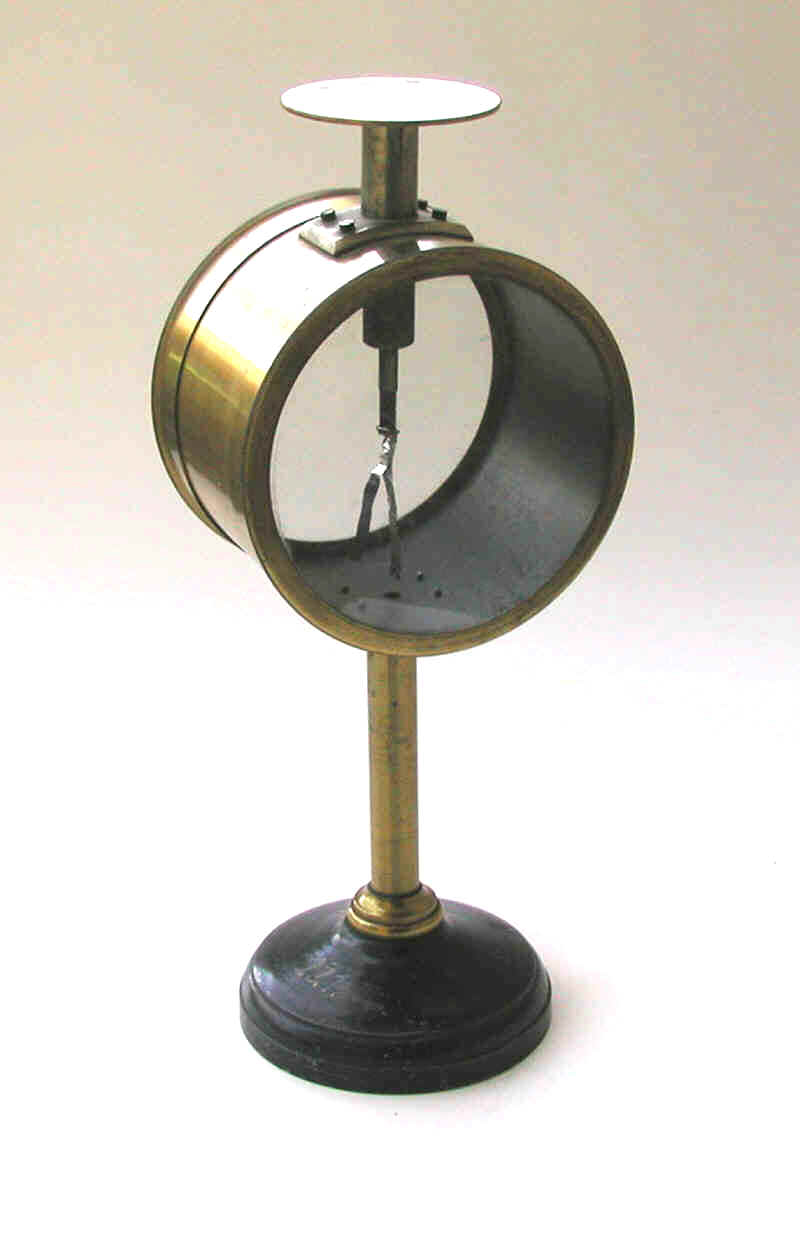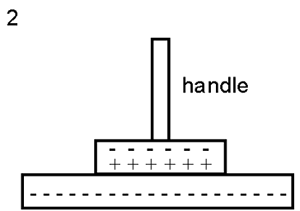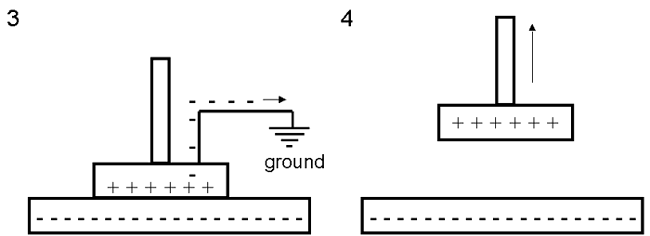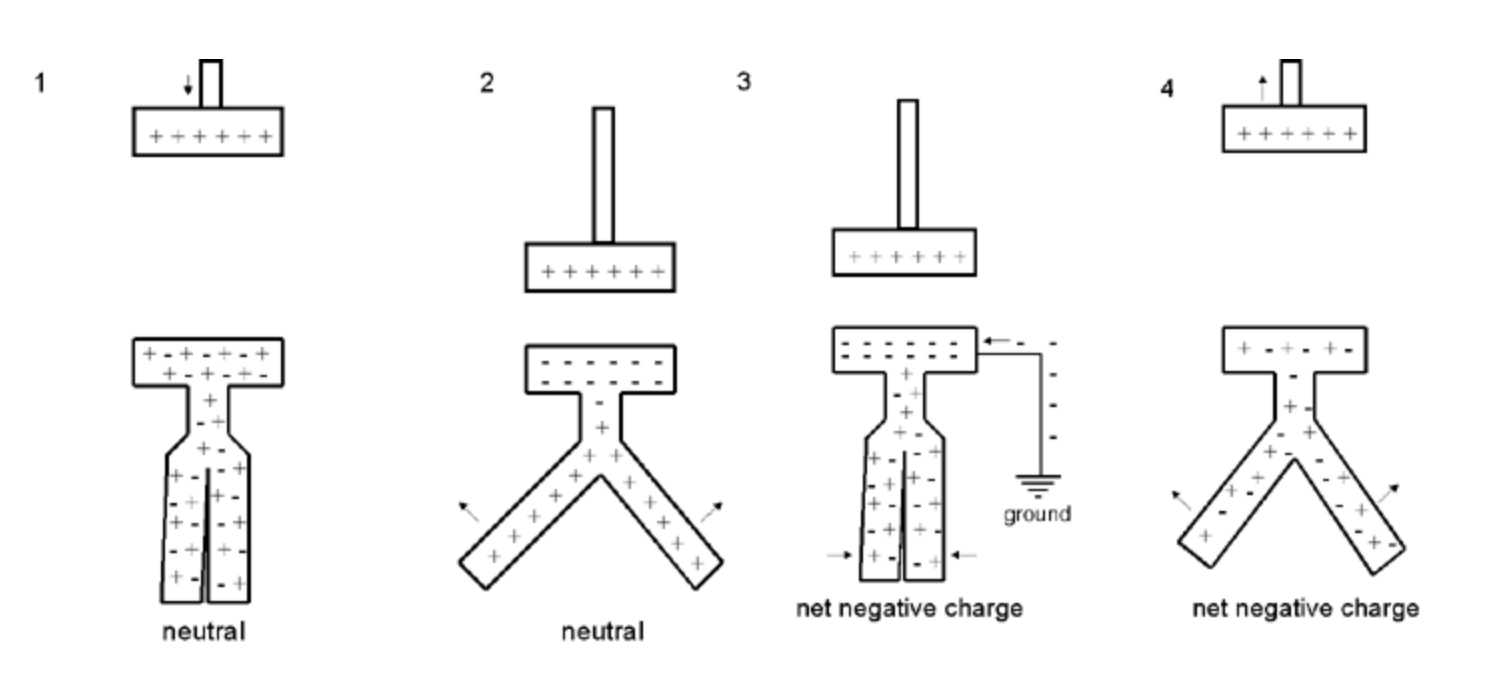Cylindrical Beetz-type Electroscope (early 1900s)

This is a cylindrical Beetz-type electroscope for qualitative demonstrations of electrostatic phenomena.
Except for the iron base and the insulator, the construction is almost entirely of brass. The two leaves appear to be aluminum. The chamber's interior has been painted black (typical for this type of instrument). This makes the leaves easier to visualize by minimizing any annoying reflections of light inside the chamber. This "paint" might be a conductive Aquadag-like compound. The manufacturer is unknown.
With regard to the usual attribution of this type of electroscope to Beetz, I can only offer the following information.
In 1873, W. Beetz provided the detailed description for a new bifilar electroscope, but the latter was nothing like the cylindrical electroscope shown above. The cylindrical style of electroscope we now attribute to Beetz was described later, in an 1876 paper of his. The paper's title, translated into English, was "On Anomalous Data of the Gold Leaf Electroscope." The following is from an English summary (1876) of Beetz's paper.
"M. Beetz makes an electroscope, in which the case is a horizontal brass tube (12 centimetres diameter and 8 centimetres long) supported on metallic feet. It is closed by vertical glass plates parallel to the plane in which the aluminum leaves diverge. It is very reliable."
The dimensions in the above description are nearly identical to the dimensions of the electroscope featured here, as well as the dimensions of the other Beetz electroscope in the ORAU collection.
It would appear that Beetz designed the cylindrical electroscope so that it would avoid some of the problems associated with glass electroscopes, e.g., a leakage of charge over the glass surfaces.
A device called an electrophorus would normally be used to charge the condenser plate.
Condensing Electroscopes and the Electrophorus
Condensing Electroscopes

The defining feature of the condensing electroscope is the flat horizontal disk on top that is connected to the electroscope leaves (or leaf). This type of electroscope is primarily intended for electrostatic measurements but it can also be used to help identify the presence of radioactive material.
A condensing electroscope is designed to be charged with the disk of a device known as an electrophorus. The dimensions of this disk are the same as those of the fixed disk on top of the electroscope. The handle of the electrophorus disk is a glass (or other insulating material) rod projecting at right angles from the back side of the disk.
Charging the Electrophorus Disk

To begin, a charge must be generated on an insulating plate once known as the cake—this plate is considered part of the electrophorus. The charged plate (Figure 1) should have a smooth surface and be made from an insulating material (Teflon is perfect but plexiglass is a good choice). The plate is charged via friction by rubbing it with a material such as wool, silk or fur. Depending on the materials used, the resulting charge on the plate would be either negative (as shown here) or positive. The back (down) side of the insulating plate might, or might not, be in contact with a conductor that is grounded.

Next, the neutral electrophorus disk is brought in contact with the insulating plate. For the purpose of this discussion, the plate is assumed to have a negative charge. Although they are in contact, the plate does not transfer a charge to the disk because the plate is an insulator. Nevertheless, there is a spatial separation of the positive and negative charges in the disk: the negative charges (electrons) are repelled to the up side of the disk farthest away from the plate thus leaving a positive charge on the down side of the disk that is in contact with the charged plate (Figure 2).
Next, the disk is grounded, e.g., by touching the top of the disk with a finger. This causes the electrons to travel to ground leaving the disk with a net positive charge (Figure 3). Finally, the ground is removed and the electrophorus disk lifted away from the insulating plate (Figure 4).

Charging the Electroscope with the Electrophorus Disk by Conduction
There are two methods that can be used to charge the electroscope: by conduction and by induction.
To charge the electroscope by conduction, the electrophorus disk, which in this example has a positive charge, is brought into physical contact with the fixed disk on the electroscope Figure 3 below). Since electrons from the electroscope are drawn to electrophorus disk, the electroscope disk and leaf will be left with a net positive charge, the same charge as that on the electrophorus.

Charging the Electroscope with the Electrophorus Disk by Induction
More control of the charge transferred to the electroscope can be obtained by charging it by induction in the following manner. The charged electrophorus disk is brought close to the fixed disk of the electroscope but the two are not allowed to touch. When the electrophorus disk is brought close, the electroscope leaves will separate. The reason is that the electrons are attracted to the upper surface of the electroscope disk, the side closest to the electrophorus, leaving the leaves with a positive charge. Since both leaves have the same charge, they separate (Figure 2). By moving the electrophorus disk away from or closer to the electroscope disk, the desired separation of the leaves can be obtained. Next the electroscope disk is grounded, e.g., by touching it. The electrons then travel to the disk leaving the electroscope with a net negative charge (Figure 3). The ground is removed (Figure 4) and the electrophorus lifted away from the electroscope leaving the electroscope with a net negative charge.

Size: ca. 12" high. The chamber is 4.75" in diameter and 3.5" deep.
References
- On Anomalous data of the Gold Leaf Electroscope by M. Beetz. Telegraphic Journal. September 15, 1876.
- Beetz, W. Ueber anomale Angaben des Goldbatts-elektroskops. Ann. de Pogg., No. 6, 1876.
- Gripon, E. Beetz, W.B. Bifilarelectroscope fur Vorlesungsversuche (Electroscope bifilaire pour les experiences de cours); Carl’s Repertorium, t. IX, p. 18,; 1873. J. Phys. Theor. Appl., 3 (1), pp.67-68. 1874.
